Get free scan and check if your device is infected.
Remove it nowTo use full-featured product, you have to purchase a license for Combo Cleaner. Seven days free trial available. Combo Cleaner is owned and operated by RCS LT, the parent company of PCRisk.com.
What is Chrome Redirect virus?
"Chrome Redirect Virus" is a generic name for all rogue applications that modify Google Chrome web browser settings. Typically, this is done without users' consent and, therefore, these applications are categorized as browser hijackers.
Research shows that, in most cases, browser hijackers infiltrate systems without permission, change settings, and gather various sensitive information.
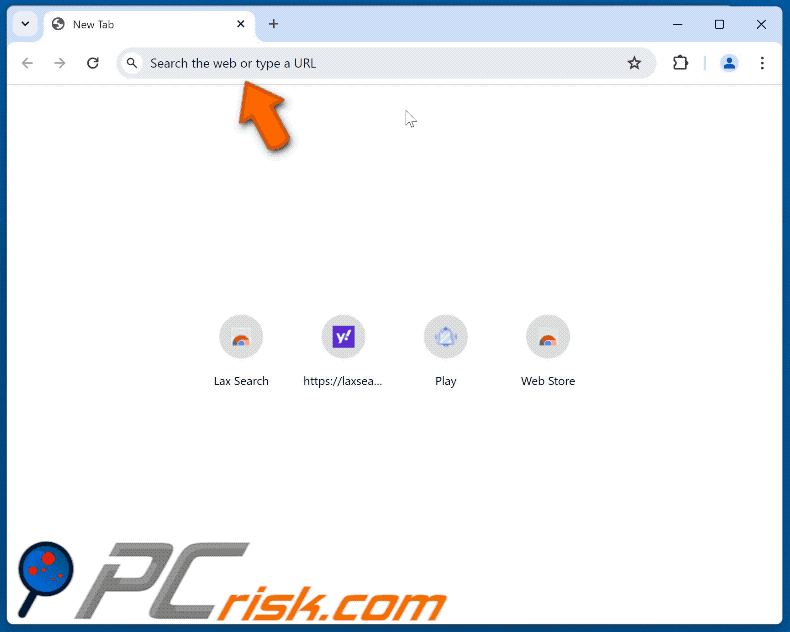
More about browser hijackers
Immediately after infiltration, browser-hijacking applications assign Google Chrome's new tab URL, default search engine, and homepage options to an alternative URL.
Therefore, users are redirected to certain websites when they search the Internet via the URL bar or simply open a browser/new browser tab. In most cases, promoted websites are fake search engines. Google Chrome is not the only web browser targeted by browser hijackers. Mozilla Firefox, Microsoft Edge and a number of other web browsers are in the list as well.
Although most browser hijackers are developed for the Windows Operating System, some target the Mac OS as well. Therefore, the Safari web browser is also at risk. The changes may seem insignificant, however, users are unable to revert them.
Research shows that most hijackers reassign browser settings when attempts are made to change them and, therefore, users are often unable to return browsers to their previous states. In order to make changes users have to firstly remove the malicious browser extension.
However, some browser hijackers are designed to abuse the "Managed By Your Organization" feature, thereby preventing users from removing the extension. By forcing users to visit certain websites, apps of this type significantly diminish the Internet browsing experience.
Examples of such browser hijackers include ISEEK, SURFSEE, SEEKSE, JDISearch, KSEARCHY, Kinsearch, UKASEE, Kaseek, Searchisty, SEARCHBOX, and ONFIND. In this case, malicious extensions cause a so-called chain redirect. Firstly, user is redirected to findflarex.com, which in turn redirects to boyu.com.tr. Causing chain redirects is also a common tactic to generate traffic for multiple websites at once.
As mentioned above, browser hijackers (and fake search engines) are very likely to collect sensitive information. The list of recorded data typically includes (but is not limited to) users' geographic locations, Internet service providers (ISPs), Internet Protocol (IP) addresses, website URLs visited, pages viewed, and search queries.
This information typically includes confidential details. In addition, developers of browser hijackers collect this data to generate revenue - they sell it to third parties (potentially, cyber criminals). These people also have identical intentions and thus there is a high probability that confidential information will be misused.
Such behavior can lead to serious privacy issues or even identity theft. If you continually encounter redirects to dubious/unwanted websites, we strongly advise you to immediately eliminate all suspicious applications/browser plug-ins and never return to these sites again.
| Name | Google Chrome browser hijacker |
| Threat Type | Browser Hijacker, Redirect, Search Hijacker, Toolbar, Unwanted New Tab |
| Symptoms | Manipulated Internet browser(s) settings (homepage, default Internet search engine, new tab settings). User's are forced to visit hijacker's website and search the Internet using their search engines. |
| Distribution methods | Deceptive pop-up ads, free software installers (bundling), fake flash player installers. |
| Damage | Internet browsing tracking (potential privacy issues), displaying of unwanted ads, redirects to shady websites. |
| Malware Removal (Windows) |
To eliminate possible malware infections, scan your computer with legitimate antivirus software. Our security researchers recommend using Combo Cleaner. Download Combo CleanerTo use full-featured product, you have to purchase a license for Combo Cleaner. 7 days free trial available. Combo Cleaner is owned and operated by RCS LT, the parent company of PCRisk.com. |
Browser hijackers in general
All browser hijackers are very similar. They offer 'useful functions' (e.g., file conversion, system optimization, anti-virus, download performance increase, and so on), however, these claims are merely attempts to give the impression of legitimacy and trick users to install. In fact, browser-hijacking apps rarely provide any real value for regular users.
They cause unwanted redirects and gather private information. In addition, fake search engines often generate false results and intrusive ads. In many cases, users are redirected to malicious sites. Therefore, using fake search engines risks computer infection.
It is worth noting that apps that get installed outside browsers (not just browser hijackers) can also be used to promote fake search engines. An example of such an app is the fake Searchify app.
How did browser hijacker install on my computer?
Some browser hijackers have official download websites, however, in most cases, they are distributed using intrusive advertisements and a deceptive marketing method called "bundling" - stealth installation of unwanted apps together with regular apps.
Developers do not disclose this information properly - they hide "bundled apps within "Custom/Advanced" settings or other sections of the download/installation processes. By skipping download/installation steps and clicking various ads, many users expose their systems to risk of various infections and compromise their privacy.
How to avoid installation of unwanted applications?
The main reasons for computer infections are careless behavior and lack of knowledge. The key to safety is caution. Therefore, to avoid unwanted installations, be very careful when browsing the Internet and, especially when downloading/installing software.
Intrusive ads often look legitimate, but once clicked, redirect to gambling, adult dating, pornography, and other dubious sites. Most are delivered by adware-type apps. If you encounter these suspicious redirects, immediately remove all dubious apps and browser plug-ins. Select "Custom/Advanced" settings and closely analyze each step of the download/installation processes.
Furthermore, decline offers to download/install additional apps and opt-out of those already included. Using a legitimate anti-virus/anti-spyware suite is also paramount.
Update January 25, 2023 - Usage of malicious Google Chrome extensions is the most popular method to cause unwanted redirects. Cyber criminals use deceptive social engineering techniques to trick users into installing said extensions. Malicious extensions are typically presented as web browser updates, as well as tools that supposedly provide a variety of useful features.
By doing so, cyber criminals create the impression of legitimacy and thus gullible users often end up unwillingly installing malicious extensions by themselves. Here are the screenshots of the latest and most popular Chrome extensions (fake Chrome extension, fake Google Docs extension, fake Google Translate extension, Clean Notifications and Landscape Scroller) that cause unwanted redirects:
Examples of fake/deceptive pop-up messages promoting such malicious browser extension:
Instant automatic malware removal:
Manual threat removal might be a lengthy and complicated process that requires advanced IT skills. Combo Cleaner is a professional automatic malware removal tool that is recommended to get rid of malware. Download it by clicking the button below:
DOWNLOAD Combo CleanerBy downloading any software listed on this website you agree to our Privacy Policy and Terms of Use. To use full-featured product, you have to purchase a license for Combo Cleaner. 7 days free trial available. Combo Cleaner is owned and operated by RCS LT, the parent company of PCRisk.com.
Quick menu:
- What is Chrome redirect virus?
- STEP 1. Uninstall unwanted applications using Control Panel.
- STEP 2. Remove browser hijackers from Google Chrome.
- STEP 3. Remove browser hijackers from Mozilla Firefox.
- STEP 4. Remove browser hijackers from Safari.
- STEP 5. Remove browser hijackers from Microsoft Edge.
Chrome redirect removal:
Windows 11 users:

Right-click on the Start icon, select Apps and Features. In the opened window search for the application you want to uninstall, after locating it, click on the three vertical dots and select Uninstall.
Windows 10 users:

Right-click in the lower left corner of the screen, in the Quick Access Menu select Control Panel. In the opened window choose Programs and Features.
Windows 7 users:

Click Start (Windows Logo at the bottom left corner of your desktop), choose Control Panel. Locate Programs and click Uninstall a program.
macOS (OSX) users:

Click Finder, in the opened screen select Applications. Drag the app from the Applications folder to the Trash (located in your Dock), then right click the Trash icon and select Empty Trash.

In the uninstall programs window: look for any recently installed suspicious applications, select these entries and click "Uninstall" or "Remove".
After uninstalling the potentially unwanted applications (which cause browser redirects to the malicious websites), scan your computer for any remaining unwanted components. To scan your computer, use recommended malware removal software.
DOWNLOAD remover for malware infections
Combo Cleaner checks if your computer is infected with malware. To use full-featured product, you have to purchase a license for Combo Cleaner. 7 days free trial available. Combo Cleaner is owned and operated by RCS LT, the parent company of PCRisk.com.
Browser hijacker removal from Internet browsers:
Video showing how to remove browser redirects:
 Remove malicious extensions from Google Chrome:
Remove malicious extensions from Google Chrome:
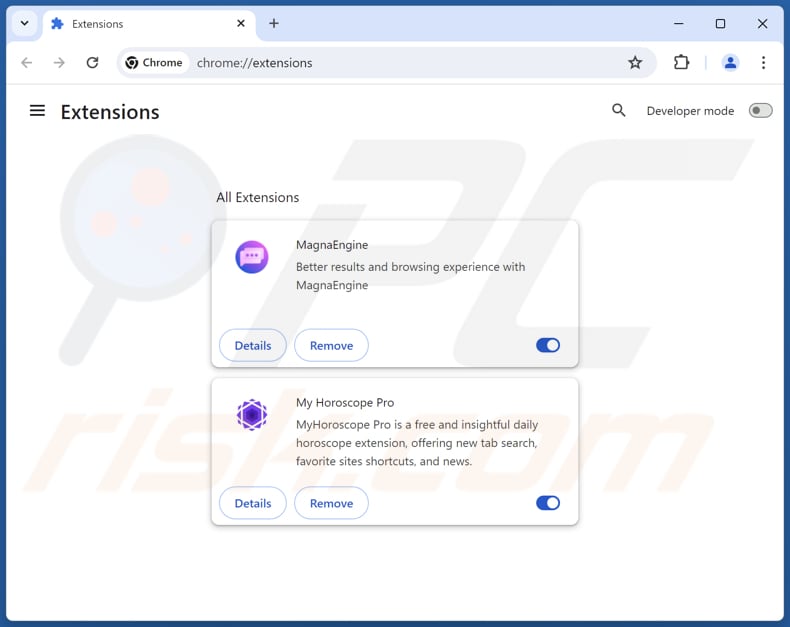
Click the Chrome menu icon ![]() (at the top right corner of Google Chrome), select "Extensions" and click "Manage Extensions". Locate all recently-installed suspicious extensions, select these entries and click "Remove".
(at the top right corner of Google Chrome), select "Extensions" and click "Manage Extensions". Locate all recently-installed suspicious extensions, select these entries and click "Remove".
Change your homepage:
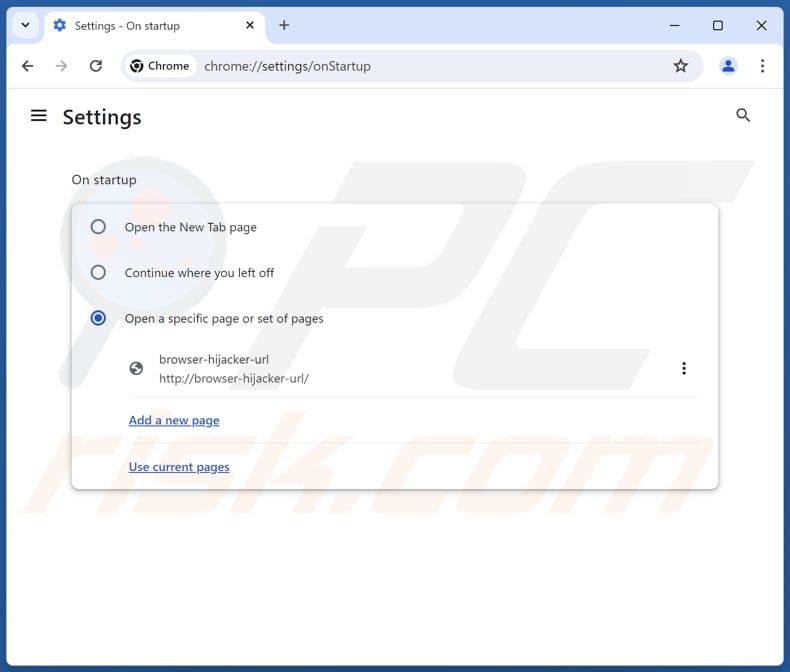
Click the Chrome menu icon ![]() (at the top right corner of Google Chrome), select "Settings". In the "On startup" section, disable the malicious extension (if present), look for a browser hijacker URL below the "Open a specific or set of pages" option. If present click on the three vertical dots icon and select "Remove".
(at the top right corner of Google Chrome), select "Settings". In the "On startup" section, disable the malicious extension (if present), look for a browser hijacker URL below the "Open a specific or set of pages" option. If present click on the three vertical dots icon and select "Remove".
Change your default search engine:
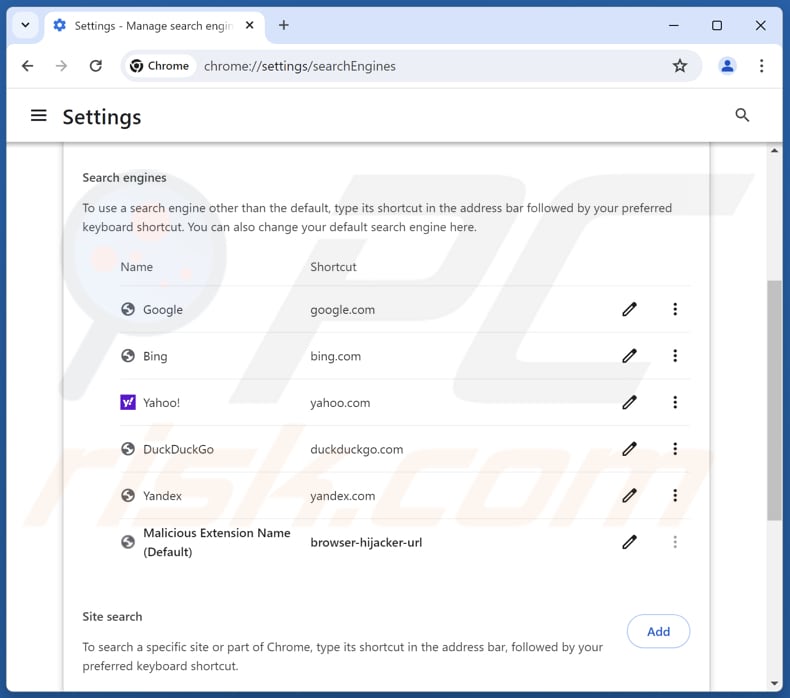
To change your default search engine in Google Chrome: Click the Chrome menu icon ![]() (at the top right corner of Google Chrome), select "Settings", in the "Search engine" section, click "Manage search engines...", in the opened list look for unwanted URL, when located click the three vertical dots near this URL and select "Delete".
(at the top right corner of Google Chrome), select "Settings", in the "Search engine" section, click "Manage search engines...", in the opened list look for unwanted URL, when located click the three vertical dots near this URL and select "Delete".
- If you continue to have problems with browser redirects and unwanted advertisements - Reset Google Chrome.
Optional method:
If you continue to have problems with removal of the google chrome browser hijacker, reset your Google Chrome browser settings. Click the Chrome menu icon ![]() (at the top right corner of Google Chrome) and select Settings. Scroll down to the bottom of the screen. Click the Advanced… link.
(at the top right corner of Google Chrome) and select Settings. Scroll down to the bottom of the screen. Click the Advanced… link.

After scrolling to the bottom of the screen, click the Reset (Restore settings to their original defaults) button.

In the opened window, confirm that you wish to reset Google Chrome settings to default by clicking the Reset button.

 Remove malicious plugins from Mozilla Firefox:
Remove malicious plugins from Mozilla Firefox:
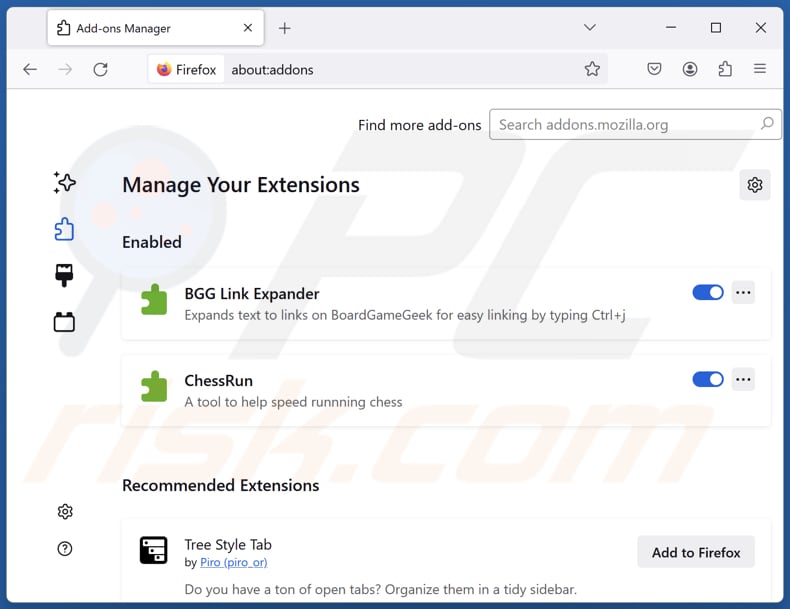
Click the Firefox menu ![]() (at the top right corner of the main window), select "Add-ons and themes". Click "Extensions", in the opened window locate all recently-installed suspicious extensions, click on the three dots and then click "Remove".
(at the top right corner of the main window), select "Add-ons and themes". Click "Extensions", in the opened window locate all recently-installed suspicious extensions, click on the three dots and then click "Remove".
Change your homepage:
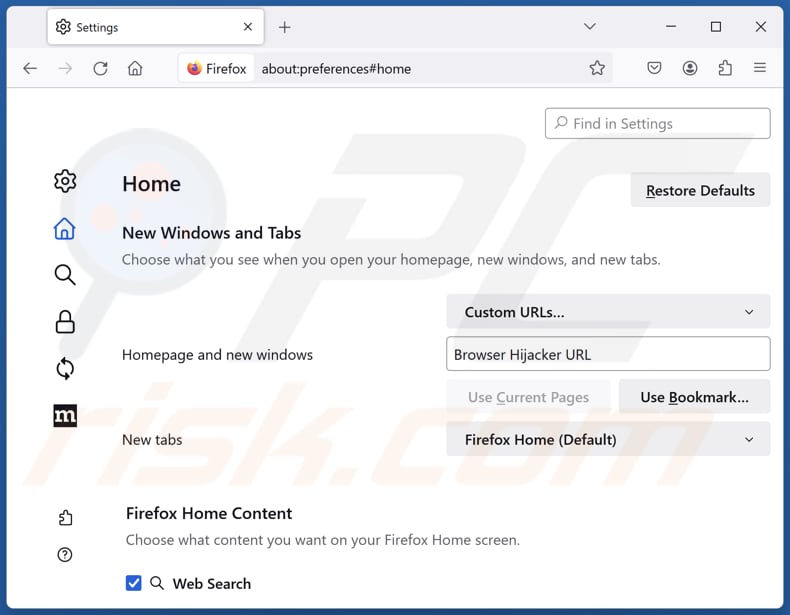
To reset your homepage, click the Firefox menu ![]() (at the top right corner of the main window), then select "Settings", in the opened window disable malicious extension (if present), remove unwanted address (e.g., browser hijacker's URL) and enter your preferred domain, which will open each time you start Mozilla Firefox.
(at the top right corner of the main window), then select "Settings", in the opened window disable malicious extension (if present), remove unwanted address (e.g., browser hijacker's URL) and enter your preferred domain, which will open each time you start Mozilla Firefox.
Change your default search engine:
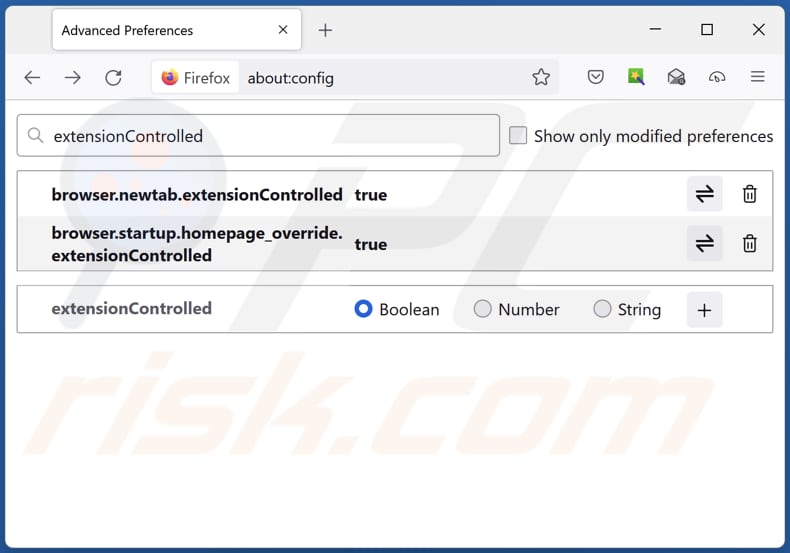
In the URL address bar, type "about:config" and press Enter. Click "Accept the Risk and Continue".
In the search filter at the top, type: "extensionControlled". Set both results to "false" by either double-clicking each entry or clicking the ![]() button.
button.
Optional method:
Computer users who have problems with google chrome browser hijacker removal can reset their Mozilla Firefox settings.
Open Mozilla Firefox, at the top right corner of the main window, click the Firefox menu, ![]() in the opened menu, click Help.
in the opened menu, click Help.

Select Troubleshooting Information.

In the opened window, click the Refresh Firefox button.

In the opened window, confirm that you wish to reset Mozilla Firefox settings to default by clicking the Refresh Firefox button.

 Remove malicious extensions from Safari:
Remove malicious extensions from Safari:

Make sure your Safari browser is active and click Safari menu, then select Preferences...

In the preferences window select the Extensions tab. Look for any recently installed suspicious extensions and uninstall them.

In the preferences window select General tab and make sure that your homepage is set to a preferred URL, if its altered by a browser hijacker - change it.

In the preferences window select Search tab and make sure that your preferred Internet search engine is selected.
Optional method:
Make sure your Safari browser is active and click on Safari menu. From the drop down menu select Clear History and Website Data...

In the opened window select all history and click the Clear History button.

 Remove malicious extensions from Microsoft Edge:
Remove malicious extensions from Microsoft Edge:

Click the Edge menu icon ![]() (at the top right corner of Microsoft Edge), select "Extensions". Locate any recently-installed suspicious browser add-ons, and remove them.
(at the top right corner of Microsoft Edge), select "Extensions". Locate any recently-installed suspicious browser add-ons, and remove them.
Change your homepage and new tab settings:

Click the Edge menu icon ![]() (at the top right corner of Microsoft Edge), select "Settings". In the "On startup" section look for the name of the browser hijacker and click "Disable".
(at the top right corner of Microsoft Edge), select "Settings". In the "On startup" section look for the name of the browser hijacker and click "Disable".
Change your default Internet search engine:

To change your default search engine in Microsoft Edge: Click the Edge menu icon ![]() (at the top right corner of Microsoft Edge), select "Privacy and services", scroll to bottom of the page and select "Address bar". In the "Search engines used in address bar" section look for the name of the unwanted Internet search engine, when located click the "Disable" button near it. Alternatively you can click on "Manage search engines", in the opened menu look for unwanted Internet search engine. Click on the puzzle icon
(at the top right corner of Microsoft Edge), select "Privacy and services", scroll to bottom of the page and select "Address bar". In the "Search engines used in address bar" section look for the name of the unwanted Internet search engine, when located click the "Disable" button near it. Alternatively you can click on "Manage search engines", in the opened menu look for unwanted Internet search engine. Click on the puzzle icon ![]() near it and select "Disable".
near it and select "Disable".
Optional method:
If you continue to have problems with removal of the google chrome browser hijacker, reset your Microsoft Edge browser settings. Click the Edge menu icon ![]() (at the top right corner of Microsoft Edge) and select Settings.
(at the top right corner of Microsoft Edge) and select Settings.

In the opened settings menu select Reset settings.

Select Restore settings to their default values. In the opened window, confirm that you wish to reset Microsoft Edge settings to default by clicking the Reset button.

- If this did not help, follow these alternative instructions explaining how to reset the Microsoft Edge browser.
Summary:
 A browser hijacker is a type of adware infection that modifies Internet browser settings by assigning the homepage and default Internet search engine settings to some other (unwanted) website URL. Commonly, this type of adware infiltrates operating systems through free software downloads. If your download is managed by a download client, ensure that you decline offers to install advertised toolbars or applications that seek to change your homepage and default Internet search engine settings.
A browser hijacker is a type of adware infection that modifies Internet browser settings by assigning the homepage and default Internet search engine settings to some other (unwanted) website URL. Commonly, this type of adware infiltrates operating systems through free software downloads. If your download is managed by a download client, ensure that you decline offers to install advertised toolbars or applications that seek to change your homepage and default Internet search engine settings.
Post a comment:
If you have additional information on google chrome browser hijacker or it's removal please share your knowledge in the comments section below.
Frequently Asked Questions (FAQ)
What is the purpose of forcing users to browser the web using a fake search engine?
The higher the number of website visitors is, the more revenue its creators generate.
Is using a fake search engine is a threat to my privacy?
To a certain extent, yes. Fake search engines can be designed to gather various information (e.g., browsing history, IP address, geolocation).
How did a browser hijacker infiltrate my computer?
Most browser hijackers are distributed using social engineering tactics, such as browser notifications displayed by shady websites and intrusive advertisements. It is also common for browser hijackers to be bundled with other programs.
Will Combo Cleaner help me remove a browser hijacker?
Yes, Combo Cleaner will scan the operating system and remove all browser hijackers from it. If multiple browser hijackers are present, they may be capable of reinstalling one another. In such cases, removing all browser hijackers at once becomes difficult. Thus, it is recommended to use Combo Cleaner to remove browser-hijacking apps and other unwanted software.
Share:

Tomas Meskauskas
Expert security researcher, professional malware analyst
I am passionate about computer security and technology. I have an experience of over 10 years working in various companies related to computer technical issue solving and Internet security. I have been working as an author and editor for pcrisk.com since 2010. Follow me on Twitter and LinkedIn to stay informed about the latest online security threats.
PCrisk security portal is brought by a company RCS LT.
Joined forces of security researchers help educate computer users about the latest online security threats. More information about the company RCS LT.
Our malware removal guides are free. However, if you want to support us you can send us a donation.
DonatePCrisk security portal is brought by a company RCS LT.
Joined forces of security researchers help educate computer users about the latest online security threats. More information about the company RCS LT.
Our malware removal guides are free. However, if you want to support us you can send us a donation.
Donate










▼ Show Discussion